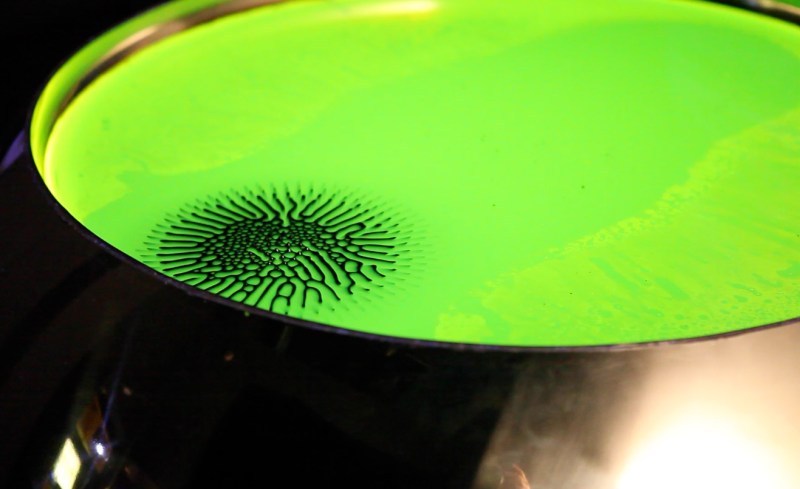Moscow artist [Dmitry Morozov] makes phenomenal geek-art. (That’s not disrespect — rather the highest praise.) And with Solaris, he’s done it again.
The piece itself looks like something out of a sci-fi or horror movie. Organic black forms coalesce and fade away underneath a glowing pool of green fluid. (Is it antifreeze?) On deeper inspection, the blob is moving in correspondence with a spectator’s brain activity. Cool.
You should definitely check out the videos. We love to watch ferrofluid just on its own — watching it bubble up out of a pool of contrasting toxic-green ooze is icing on the cake. Our only wish is that the camera spent more time on the piece itself.
Two minutes into the first video we get a little peek behind the curtain, and of course it’s done with an Arduino, a couple of motors, and a large permanent magnet. Move the motor around with input from an Epoc brain-activity sensor and you’re done. As with all good art, though, the result is significantly greater than the sum of its parts.
[Dmitry’s] work has been covered many, many times already on Hackaday, but he keeps turning out the gems. We could watch this one for hours.















Neat! I’d like to see something like that with a more advanced (electro)magnet setup.
Doesn’t look like antifreeze to me, it looks like the flourescing fluid from a bunch of glow sticks. Definitely a really neat idea combining the two so it hides the ferrofluid like that. I could see some really neat displays happening because of that.
Or highlighter?
Antifreeze is blacklight/uv reactive. That can definitely be antifreeze. It does come in multiple colors (blue, green, red, depending on make)
Yeah – it also looks like there’s blacklights in the video, so that’s pretty much confirmed.
Look up time-fountains, They use highlighter ink dissolved in water. Same exact effect and I’m pretty sure thats what they used.
Awesome installation, brings new meaning to artwork interacting with the viewer, eh?
Hard to believe you can get one of those EPOC headsets for 400$. A decade ago that’d have a few extra zeros!
So basically, a cnc with an extra axis for curved movement
Cool. Oh by the way, although I’m sure you know, it’s called Solaris after the book by Lem, I guess it represents the ocean of the planet, reading minds and reacting to them.
http://en.wikipedia.org/wiki/Solaris_(novel)
woo, puredata and opensoundcontrol!
That does look very organic. And reminiscent of the oil slick creature from Creepshow 2, which as it happens, played here yesterday. CREEEEPY
take a look at similar “artwork” by MIT researchers in 2003-
http://newsoffice.mit.edu/2003/ferrofluid-0205
it seems that the amazing “vanishing” effect in dmitrys work is caused by the the ferrofluid being suspended in the carrier liquid, making it practically invisible. in the presence of a strong magnetic field the ferrofluid clumps and becomes visible in beautiful patterns. what MIT did was quite complex – they used a carrier fluid which is clear but seperate from the black ferro, and used ~60Hz rotating strong magnetic field on the small vial.
the result is astonishing. I tried replicating it but could not find the proper carrier fluid, that will prevent the ferro from just creating a big mess. this article made me realize that I can retry this now that I can afford to buy a pre-made vial such as – http://www.thinkgeek.com/product/f025/
Wow. HaD feels the need to write a disclaimer in its first line, explaining the phrase “phenomenal geek-art” is not meant to be disrespectful.
Leaving aside the positive tone of the opening paragraph, who the heck do the editors think their audience is? “Oh it’s geeky, but its cool guys!”
Adding the disclaimer reminds me of the person who adds “no disrespect” or “not that I’m a racist, but…” to statements that clearly don’t need them.
Also, fascinating. Wish there were more details on the system and more eye-candy staring into the glowing pool.
The green color is Sodium Fluorescin. Its water soluble and non-toxic. https://en.wikipedia.org/wiki/Fluorescein